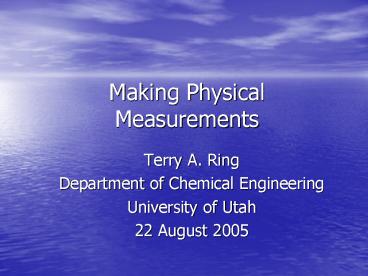Making Physical Measurements - PowerPoint PPT Presentation
Title:
Making Physical Measurements
Description:
Making Physical Measurements Terry A. Ring Department of Chemical Engineering University of Utah 22 August 2005 OVERVIEW Course experiments general approach to ... – PowerPoint PPT presentation
Number of Views:88
Avg rating:3.0/5.0
Title: Making Physical Measurements
1
Making Physical Measurements
- Terry A. Ring
- Department of Chemical Engineering
- University of Utah
- 22 August 2005
2
OVERVIEW
- Course experiments general approach to making
physical measurements - Terminology
- Calibration
- Types of Instruments
- Class Participation
3
Experiments
- Preparation for an experiment - organization
teamwork - time management - Equipment/apparatus - keep detailed list of
equipment/chemicals - know your
equipment/capabilities - most equipment
expensive, do not abuse or neglect
4
Important Terms
- Error the difference between the true value
and the observed (measured) value - Random error fluctuations in the measured value
due to repeated measurements - Systematic error all measured values are off by
the same amount due to a) incorrect calibration
b) faulty equipment c) other causes - Illegitimate error erroneous method/technique,
goofs
5
Random Error Sources
- Judgement errors, estimate errors, parallax
- Fluctuating Conditions
- Digitization
- Disturbances such as mechanical vibrations or
static electricty caused by solar activity - Sampling
6
Systematic Error Sources
- Calibration of instrument
- Environmental conditions different from
calibration - Technique not at equilibrium or at steady
state. - Sampling
7
Digitization Error
- Analogue Signal
- mV, mA, Volts, Amp, Watts, other
- Amplification to Industrial Std Scales
- 4 to 20 mA
- 5 to -5 V
- Digitization
- Step size Scale/(2N)
- N bits in a byte of A-to-D board
- Calculation Precision 8, 10, 12 16 digits or 32
digits of binary words are common
8
Important Terms
- Accuracy - a measure of how close the result
comes to the true value (correctness). An
indication of how well we control systemic
errors. - Precision a measure of how exactly the result
is determined (reproducibility) no relation to
true value. An indication of how well we
overcome or analyze random errors - Limit of detection smallest value which can be
detected.
9
Important Terms
- Discrepancy the difference between values for
the same measurement - Uncertainty an estimate of the range in the
error. Always determined for a particular
confidence level, i.e.
10
Experiments
- Literature work- understand theory/principles/con
cepts from textbooks and references - References- textbook- Perrys chemical
engineers handbook- CRC handbook of
chemistry/physics- Instrument Engineers
Handbook- process measurement and analysis
B.G. Liptak, ed.- Web sites
11
Potential Problems
- Paralax
- Scale Interpretation
- Appropriate Scale
- Appropriate Instrument
- Appropriate detection limits
- Signal to Noise ratio
- Appropriate Accuracy and Precision
- Significant Figures
12
WHAT PRECISION IS REQUIRED?
- Overall Precision
- Impact on Calculation
- Difficulty of Measurement
13
Calibration
- Should use primary standards if possible
- Calibrate as close to measuring conditions as
possible - Sometimes performed at
- the factory
- Professional laboratories
- Laboratory standards ice bath, constant temp
bath - Tabulated properties and relationships boiling
water at barometric pressure triple point of
water - Linear vs Non-linear Calibration curves
14
Types of Instruments
- Off-line Process Instrumentation
- Density Measurement
- Weight and Misc. Sensors
- Analytical Instrumentation
- Issues
- Sampling
- Grab sample
- Statistical Sampling
- Sample Preparation
- Splitting, extraction, decomposition
- Online Instrumentation
- Flow Measurement
- Level Measurement
- Temperature Measurement
- Pressure Measurement
- Safety
Quantitative
15
Liquid Density Measurement
- Hydrometers (based upon buoyancy)
- Pycnometer (based on weight)
- Weighing a fixed volume
- Oscillating Coriolis Densitometers
- Hydrostatic Densitometers
- Radiation Densitometers liquid/sludge
- Vibrating Densitometers Liq/sludge/gas
16
Analytical Instrumentation
- Viscometers
- Spectrophotometers
- IR
- UV-Visible
- Chromatographs
- Ion-selective Electrodes
- Mass Spectrometers
- Inductively Coupled Plasma Spectrometer
- Many, many more
17
Types of Analysis
- Content Analysis What is in it?
- Qualitative
- Semi-Quantitative
- Quantitative
- Distribution Analysis Where is it?
- Process Analysis When does it occur?
- Structural Analysis What is its structure?
18
Analytical Strategies
- Sampling
- Sample Preparation
- Analytical Principle
- Analytical Procedure
- Decomposition Methods
- Separation Methods
- Enrichment Methods
- Measurement Methodology
- Measurement Results
- Accuracy
- Precision
19
CONCLUSIONS
- KNOW YOUR EQUIPMENT
- Know its limitations and strengths
- CHOOSE THE RIGHT PRECISION
- CALIBRATE AS MUCH AS POSSIBLE
- UNDERSTAND THE LIMITATIONS OF YOUR EQUIPMENT
- LEARN THE TERMINOLOGY
20
Audience Participation































